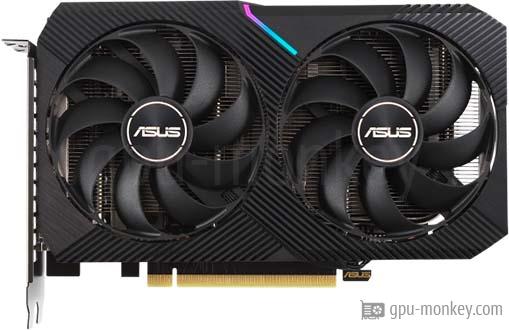ASUS Dual GeForce RTX 3050 8GB in 3DMark Benchmark (DirectX, Raytracing)
Here you can see how fast the ASUS Dual GeForce RTX 3050 8GB is in 3DMark Benchmark (DirectX, Raytracing). The performance of the graphics card in benchmarks or games primarily depends on the GPU architecture, the number of texture shaders and the memory size. The ASUS Dual GeForce RTX 3050 8GB has 8 GB GDDR6 memory.
GPU |
|
| Based on: | NVIDIA GeForce RTX 3050 |
| GPU Chip: | GA106-150-A1 (Ampere) |
| Streaming Multiprocessors: | 20 |
| Shader: | 2560 |
| Raytracing Cores: | 20 |
Memory |
|
| Memory Size: | 8 GB |
| Memory Type: | GDDR6 |
| Memory Clock: | 1.750 GHz |
| Memory bandwidth: | 224 GB/s |
| Memory Interface: | 128 bit |
Benchmark results
3DMark Benchmark (DirectX, Raytracing)
3DMark is a benchmark program that determines the performance of certain components of a computer and then reports the performance as a numerical value.Time Spy Graphics score
|
|
ASUS Dual GeForce RTX 3050 8GB
8 GB GDDR6 |
||
|
|
NVIDIA GeForce RTX 3050
Average of gpu group |
||
Time Spy Extreme Graphics score
|
|
ASUS Dual GeForce RTX 3050 8GB
8 GB GDDR6 |
||
|
|
NVIDIA GeForce RTX 3050
Average of gpu group |
||
Fire Strike Extreme Graphics score
|
|
ASUS Dual GeForce RTX 3050 8GB
8 GB GDDR6 |
||
|
|
NVIDIA GeForce RTX 3050
Average of gpu group |
||
Port Royal (Raytracing)
|
|
ASUS Dual GeForce RTX 3050 8GB
8 GB GDDR6 |
||
|
|
NVIDIA GeForce RTX 3050
Average of gpu group |
||
Speed Way Graphics Score (Raytracing)
|
|
ASUS Dual GeForce RTX 3050 8GB
8 GB GDDR6 |
||
|
|
NVIDIA GeForce RTX 3050
Average of gpu group |
||
More benchmarks for the graphics card
ASUS Dual GeForce RTX 3050 8GB
In order to determine the performance of a graphics card, so-called "benchmarks" are carried out. The benchmark software carries out special calculations to determine the performance of a graphics card. We use so-called theoretical or synthetic benchmarks (e.g. 3D Mark) as well as real game benchmarks. To ensure real comparability of the results, we pay attention to the correct execution of the benchmarks as well as the condition of the graphics card and the system.We use the following benchmarks to measure the performance of a graphics card:
3DMark Benchmark
5,159 entries
5,159 entries
Cyberpunk 2077
2,942 entries
2,942 entries
The Last of Us Part 1
2,058 entries
2,058 entries
GTA 5 Benchmark
4,624 entries
4,624 entries
Shadow of the Tomb Raider
5,148 entries
5,148 entries
Battlefield 5
4,510 entries
4,510 entries
Geekbench 6
5,151 entries
5,151 entries
Crypto-Mining Ethereum Hashrate
3,506 entries
3,506 entries
Crypto-Mining Ergo Hashrate
3,737 entries
3,737 entries
Crypto-Mining Ravencoin Hashrate
3,664 entries
3,664 entries
FP32 Performance
5,522 entries
5,522 entries
GPUs by group
Here we have listed more GPU groups for you:
AMD Radeon RX 7600
8 GB GDDR6
8 GB GDDR6

AMD Radeon RX 7600 XT
16 GB GDDR6
16 GB GDDR6

AMD Radeon RX 7700 XT
12 GB GDDR6
12 GB GDDR6

AMD Radeon RX 7800 XT
16 GB GDDR6
16 GB GDDR6

AMD Radeon RX 7900 XT
20 GB GDDR6
20 GB GDDR6

AMD Radeon RX 7900 XTX
24 GB GDDR6
24 GB GDDR6

NVIDIA GeForce RTX 4060
8 GB GDDR6
8 GB GDDR6

NVIDIA GeForce RTX 4060 TI (16GB)
16 GB GDDR6
16 GB GDDR6

NVIDIA GeForce RTX 4060 TI (8GB)
8 GB GDDR6
8 GB GDDR6

NVIDIA GeForce RTX 4070
12 GB GDDR6X
12 GB GDDR6X

NVIDIA GeForce RTX 4070 SUPER
12 GB GDDR6X
12 GB GDDR6X

NVIDIA GeForce RTX 4070 Ti
12 GB GDDR6X
12 GB GDDR6X

NVIDIA GeForce RTX 4070 Ti SUPER
16 GB GDDR6X
16 GB GDDR6X

NVIDIA GeForce RTX 4080
16 GB GDDR6X
16 GB GDDR6X

NVIDIA GeForce RTX 4080 SUPER
16 GB GDDR6X
16 GB GDDR6X

NVIDIA GeForce RTX 4090
24 GB GDDR6X
24 GB GDDR6X
More GPU groups
show more results
show more results
back to index
